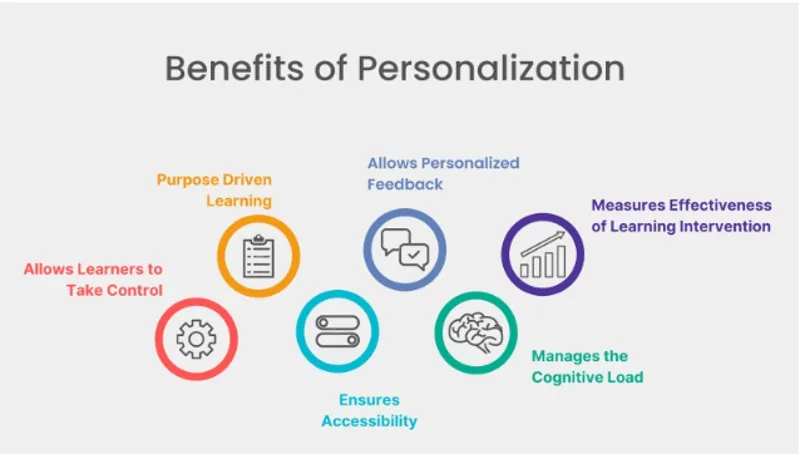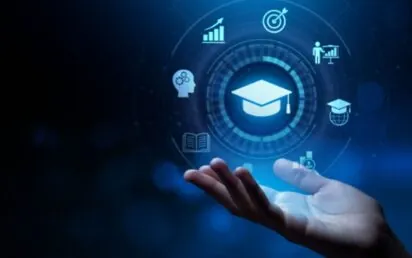In the times of the COVID-19 pandemic, the education sector experienced fundamental change. There had already been numerous robust eLearning solutions, but with worldwide lockdowns, online education became the norm, not just an exciting option. The turbulent times of restrictions are gone, but the learning techniques and innovations developed back then linger. What’s more, for certain activities, the online format has become the primary option (various tests, etc.).
The global eLearning market is projected to surpass $457.8 billion by 2026. So, we can expect a multitude of thrilling innovations in the years to come. Let’s explore some of the biggest trends to follow in 2024.
What is EdTech and Why It Is Relevant Nowadays
EdTech stands for education technology, and its primary aim is facilitating teaching and learning. It is very versatile—online courses, LMS software, collaborative platforms, VR-powered classes, AI support, and more. As educational organizations are closely connected with academic research, aspiring institutions strive to bring something new and unique. They engage leading scientists to develop such solutions. Certain digital products serve the same purpose, but they come in a variety of forms.
Several factors have contributed to the rise of this sector:
- Accessibility: Learners can easily access courses and educational materials remotely, which is of great value for those who need flexible scheduling. Furthermore, the chance to attend classes from any corner of the world attracts people from different countries. An online school offering its services worldwide opens the doors for anyone, no matter their nationality and country of residence.
- Engagement: Interactive tools, like gamification, simulations, and adaptive software motivate learners and make them much more interested in subjects they master.
- Personalization: Sophisticated educational solutions leverage data analytics to provide personalized instruction based on each learner’s strengths, weaknesses, and preferences.
- Cost-effectiveness: EdTech enables scalable delivery of instruction at a lower cost per student compared to traditional classroom-based education.
- Lifelong learning: Digital education platforms make it easy for working professionals to continue skill-building and companies to train employees.
EdTech will only become more sophisticated and integrated into education in the coming years.

Top Trends to Follow
The following trends are not new, but it is beyond doubt that these will remain relevant throughout the year 2024 and beyond.
Immersive Learning
Education is a fertile ground for applying virtual reality and augmented reality. People are lifelong learners, and the excitement of learning an unknown fact is close to that of a kid discovering the world day by day. It’s widely recognized that one of the most efficient techniques in the process of education, whether in conventional classroom activities or online classes, is experiencing something firsthand. Immersive technologies are perfect for these purposes.
As a history student, you can easily be transported to the 19th century—simply put on a VR headset and witness industrialization with railway stations under construction, steaming locomotives rushing through wintry forests, and more. If you are a medical student, you have a wonderful opportunity to study anatomy or practice operations in a virtual operating room.
Simulated environments are excitingly realistic, whether it be exploring Mars, conducting virtual science experiments, or reliving historical events. AR overlays digital information and media onto the physical world, bringing subjects to life—imagine seeing diagrams overlaid on an engine as you learn how it works.
Increased motivation and enjoyment are self-evident benefits of immersive technologies. And a motivated student has more chances for success. What’s more, AR and VR allow educational professionals to work out learning activities that encompass different learning styles—visual, auditory, and kinesthetic. As a result, immersive learning boosts knowledge retention and in certain situations exceeds traditional classroom-based learning.

Gamification
Organizations adopting gamification seek to boost involvement, a crucial element for educational endeavors. From kindergarten children engaging in educational games to professionals refining their expertise, the appeal of gaming remains constant, albeit with varying degrees of complexity.
EdTech platforms with built-in gamification mechanisms boost student motivation and engagement. Points, levels, challenges, and virtual rewards like badges, leaderboards, and real-world prizes are examples of gamification techniques that can be introduced into the learning experience.
Such functionality is necessary as it taps into learners’ innate desires for competition, achievement, and progression. Educational games and gamified learning management systems turn the entire process from a potentially tedious experience into a very exciting activity. Participation in games and enjoyable challenges are reasons enough to embrace such practices. But there are even more benefits. Gamification makes users smile, actively plunge into lessons, and long for more excitement—briefly, it makes them happy. And when one is happy, one is ready to conquer any peak.
As an outcome, gamification improves academic performance, collaboration, and student participation. As learners earn rewards and recognition for progress, they stay much more engaged. Young digital native students are especially receptive to gamification.

Artificial Intelligence
AI is gradually becoming an indispensable part of almost any sector, and educational platforms are no exception. Intelligent technology significantly enhances the capabilities of human professionals, making it essential for any organization. By automating administrative tasks, teachers gain more time for creative endeavors. Smart technology can thoroughly analyze student performance data and identify insights, aiding teachers in adjusting learning processes. Smart tutoring systems offer personalized, supplemental teaching.
For example, Google’s Workspace for Education employs ML to streamline assignments and feedback. Some companies deliver smart teaching assistants tailored for K-12 classrooms. These innovative tools accurately answer questions of learners, generate quizzes, and more.
While AI won’t eliminate teacher burnout on its own, it can alleviate some burdens. Specialists spend a disproportionate amount of time on clerical work, it’s always been like that. However, with automated tasks, they gain valuable time that they can use to help students or pupils.
Of course, AI is far from being a substitute for human teachers. But as an additional tool, it does wonders.

Innovative Solutions for School Networks
With the development of educational software, hardware demands grow as well. The influx of connected devices and applications in schools and universities is massive, so each institution needs a separate IT department to handle all these assets. Professionals working in such departments will use advanced solutions to monitor and optimize increasingly complex network infrastructure.
Network analytics dashboards aggregate data on bandwidth usage, device connectivity, access point signal strength, UX metrics, and more. Remote network management enables tech professionals to tweak settings, troubleshoot issues, and load balance traffic without on-site visits.
For organizations with thousands of students and teaching professionals, robust network management tools are becoming imperative.
Personalized Learning
Learners are as different as people themselves. We all have different memory capacities, special aptitudes, or learning paces. So, there is no such thing as a universal learning model. Ideally, each student should have their own learning program. While this sounds utopian, eLearning comes closer to this than traditional classroom techniques—software solutions allow users to configure settings for their purposes.
Innovative digital products use smart algorithms and advanced data analytics to generate tailored learning pathways. Thus, each learner—be it a university student or a specialist attending corporate classes—receives their version of a program. Of course, hyperpersonalization is not always necessary, still, such an opportunity exists. Smart algorithms track and analyze individuals’ proficiencies, learning gaps, engagement levels, and pace to build customized journeys.
Users get adaptive sequencing of content, targeted recommendations of lessons and assignments, and adjustable difficulty levels. As a person progresses in their studies, the platform continuously refines its model of their needs and performance. Such individualization is a massive shift away from the “one-size-fits-all” approach of conventional education.
The advantage is obvious: learners can now focus on exactly what they need to learn without wasting time. And in such a scenario, teachers will see much better outcomes and grateful students.

Blockchain for Credentialing
Universities and other institutions worldwide are gradually adopting blockchain. The experience of FinTech leaders—pioneers in this field—seems convincing. That’s why educators also want to leverage innovative software to reach a new level of transparency, security, and portability to certifications and credentials. Advanced verification mechanisms mean that educational systems employ decentralized, distributed ledgers to create tamper-proof, shareable records of academic achievements or professional certifications.
This is beneficial not only for institutions but for learners as well. Students can securely share their credentials with employers, who can verify the legitimacy and details of their qualifications. Learners also get a portable credential profile—and they use it whenever needed, throughout their career. Universities, institutes, or schools also see an immense advantage: manual paperwork can be drastically reduced, and organizations can issue and validate credentials with no paper transcripts. This is both convenient and secure.
Blockchain credentialing reduces fraud risk, cuts administrative overhead, and allows students to justify their achievements. It solves problems with how certifications are traditionally distributed and verified. The decentralization that blockchain comes with ensures credentials are reliable and easy to share.

Smart Content Recommendations
As education means dealing with huge information flows, singling out the key content is essential. Of course, the more you read, the better you understand certain things. However, it is necessary to prioritize the most important pieces of information.
In this respect, smart algorithms are miraculous. Thanks to them, EdTech platforms provide personalized and smart recommendations of learning content tailored to each student. Platforms analyze vast amounts of data related to an individual’s knowledge levels, interests, learning styles, pace, and more—and thus can curate and suggest content likely to resonate with that particular learner.
Smart recommendation engines help overcome information overload by predicting the optimal content—e.g., articles, videos, courses, assessments—to serve each user based on who they are and where they are at in their learning journey. As a result, students are much more motivated and engaged—a significant achievement for them and their teachers.
Moreover, with such an approach, educational institutions or organizations offering classes can address the preferences of each learner. Some prefer visual materials, while others would rather choose audio or video files. Leading eLearning platforms have all of this—and their databases grow with each year. So, you’ll definitely find what suits you most.
As smart software solutions advance, EdTech recommendation algorithms will become incredibly tuned to individual needs, providing each learner with precisely the right content at the right time.

Social Learning Platforms
Social and collaborative learning are pillars of successful education. That’s why platforms offering such capacities will gain traction. Thanks to them, people can interact and share knowledge, gain insights into new realms, and so on. All this is important for any learner who wants to progress. After all, you learn not only for yourself—you will most likely use your knowledge in some working environment or a situation involving others. Professionals developing LMS software will further implement social features that foster teamwork, peer-to-peer support, and relationship building.
Discussion forums, built-in messaging, study groups, live chat, collaborative annotations, knowledge boards, and gamification that rewards engagement are some examples of social learning capabilities that modern EdTech solutions offer.
Such systems boost motivation, accountability, and outcomes by tapping into learners’ innate preferences for interaction. As education becomes more digitized, expect to see social connection remain central rather than diminish.

Microlearning for Skill Development
Ongoing, continuous development is a prerequisite for success. That’s why schoolchildren and university students revise the material they learn. However, this approach is also relevant for professionals who attend learning courses to enhance their knowledge. What EdTech platforms offer in this respect are modular and stackable learning experiences. Thanks to this, users can considerably strengthen their skills.
So, microlearning through short videos and modules is one of the top trends in 2024. Each of these modules teaches a discrete skill. You can choose those that are interesting or relevant to you, and then, whenever needed, expand your knowledge base. This is a godsend for specialists willing to hone their skills in a particular field. Many EdTech platforms offer flexible subscription models for such solutions. Individuals can cost-effectively gain niche skills demanded by the market, and employers can train and re-train employees in-house.
Continuous learning bridges skills gaps and fosters a culture of growth and flexibility.

Enhanced Data Analytics
Any organization wants to improve its services, so, this trend is relevant for educators. With innovative data analytics tools, schools and universities unlock extra levels of education intelligence. As a result, professionals—both instructors and managers—make sound decisions and introduce innovative educational techniques. And implementing such tools is quite easy: EdTech platforms capture immense amounts of data. It covers students’ engagement levels and participation, performance patterns across assignments and assessments, educational materials, and much more.
Predictive modeling and ML turn this data into insights. Teachers can use dashboards that show trends across the classroom, flag at-risk students, and spot knowledge gaps needing attention. Institutions can pinpoint teaching methods and resource allocations that improve outcomes.
Relevant and rich data is key for continuous improvement.

Conclusion
2024 promises to be an exciting year for EdTech, marked by immersive experiences, innovation, personalization, and a commitment to continuous self-development. The possibilities are exciting, but successfully integrating these innovations takes thoughtful planning, stakeholder engagement, and partnership with experienced IT providers.
As schools and universities evaluate their EdTech roadmaps, teaming up with an established software development company that specializes in building innovative eLearning solutions can help ensure new technologies positively impact learners.


